Potrebujeme váš súhlas na využitie jednotlivých dát, aby sa vám okrem iného mohli ukazovať informácie týkajúce sa vašich záujmov. Súhlas udelíte kliknutím na tlačidlo „OK“.
ASTM D6954-04(2013)
Standard Guide for Exposing and Testing Plastics that Degrade in the Environment by a Combination of Oxidation and Biodegradation
Automaticky preložený názov:
Štandardné Guide pre vystavenie a testovanie plastov, ktoré v prostredí rozkladať kombinácií oxidácie a biodegradácia
NORMA vydaná dňa 1.1.2013
Informácie o norme:
Označenie normy: ASTM D6954-04(2013)
Poznámka: NEPLATNÁ
Dátum vydania normy: 1.1.2013
Kód tovaru: NS-37112
Počet strán: 6
Približná hmotnosť: 18 g (0.04 libier)
Krajina: Americká technická norma
Kategória: Technické normy ASTM
Kategórie - podobné normy:
Anotácia textu normy ASTM D6954-04(2013) :
Keywords:
biodegradation, ecotoxicity, environmental degradation, oxidation, photooxidation, thermal, ICS Number Code 83.080.01 (Plastics in general)
Doplňujúce informácie
| Significance and Use | ||||||||||||||||||||||||||||||
|
5.1 This guide is a sequential assembly of extant but unconnected standard tests and practices for the oxidation and biodegradation of plastics, which will permit the comparison and ranking of the overall rate of environmental degradation of plastics that require thermal or photooxidation to initiate degradation. Each degradation stage is independently evaluated to allow a combined evaluation of a polymer’s environmental performance under a controlled laboratory setting. This enables a laboratory assessment of its disposal performance in, soil, compost, landfill, and water and for use in agricultural products such as mulch film without detriment to that particular environment. 5.2 The correlation of results from
this guide to actual disposal environments (for example,
agricultural mulch films, composting, or landfill applications) has
not been determined, and as such, the results should be used only
for comparative and ranking purposes.
5.3 The results of laboratory exposure cannot be directly extrapolated to estimate absolute rate of deterioration by the environment because the acceleration factor is material dependent and can be significantly different for each material and for different formulations of the same material. However, exposure of a similar material of known outdoor performance, a control, at the same time as the test specimens allows comparison of the durability relative to that of the control under the test conditions. |
||||||||||||||||||||||||||||||
| 1. Scope | ||||||||||||||||||||||||||||||
|
1.1 This guide provides a framework or road map to compare and rank the controlled laboratory rates of degradation and degree of physical property losses of polymers by thermal and photooxidation processes as well as the biodegradation and ecological impacts in defined applications and disposal environments after degradation. Disposal environments range from exposure in soil, landfill, and compost in which thermal oxidation may occur and land cover and agricultural use in which photooxidation may also occur. 1.2 In this guide, established ASTM International standards are used in three tiers for accelerating and measuring the loss in properties and molecular weight by both thermal and photooxidation processes and other abiotic processes (Tier 1), measuring biodegradation (Tier 2), and assessing ecological impact of the products from these processes (Tier 3). 1.3 The Tier 1 conditions selected for thermal oxidation and photooxidation accelerate the degradation likely to occur in a chosen application and disposal environment. The conditions should include a range of humidity or water concentrations based on the application and disposal environment in mind. The measured rate of degradation at typical oxidation temperatures is required to compare and rank the polymers being evaluated in that chosen application to reach a molecular weight that constitutes a demonstrable biodegradable residue (using ASTM International biometer tests for CO2 evolution appropriate to the chosen environment). By way of example, accelerated oxidation data must be obtained at temperatures and humidity ranges typical in that chosen application and disposal environment, for example, in soil (20 to 30°C), landfill (20 to 35°C), and composting facilities (30 to 65°C). For applications in soils, local temperatures and humidity ranges must be considered as they vary widely with geography. At least one temperature must be reasonably close to the end use or disposal temperature, but under no circumstances should this be more than 20°C away from the removed that temperature. It must also be established that the polymer does not undergo a phase change, such as glass transition temperature (Tg) within the temperature range of testing. 1.4 The residues resulting from the oxidations are then exposed to appropriate disposal or use environments in standard biometric test methods to measure the rate and degree of biodegradation (Tier 2). 1.5 The data generated under Tier 1 evaluation and the determined time for the biodegradation in the chosen environment (Tier 2) allow ranking relative to other polymers evaluated under similar environmental conditions with this guide. The degree and time for biodegradation should be consistent with ASTM International methods, and any residues from the intermediate oxidation stage and from biodegradation must be shown to be environmentally benign and not persistent (Tier 3). 1.6 It is cautioned that the results
of any laboratory exposure in this guide cannot be directly
extrapolated to actual disposal environments; confirmation to real
world exposure is ultimately required as with all ASTM
International standards.
1.7 The values stated in SI units are to be regarded as standard. 1.8 This standard does not
purport to address all of the safety concerns, if any, associated
with its use. It is the responsibility of the user of this standard
to establish appropriate safety and health practices and determine
the applicability of regulatory requirements prior to use.
|
||||||||||||||||||||||||||||||
| 2. Referenced Documents | ||||||||||||||||||||||||||||||
|
Podobné normy:
Historická
1.4.2010
Historická
15.12.2012
Historická
1.10.2010
Historická
1.12.2011
Historická
15.3.2007
Historická
15.3.2007


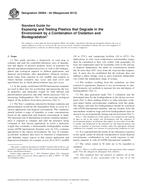
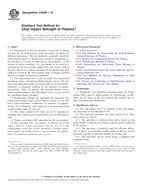 ASTM D4508-10
ASTM D4508-10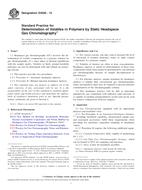 ASTM D4526-12
ASTM D4526-12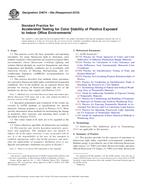 ASTM D4674-02a(2010)..
ASTM D4674-02a(2010)..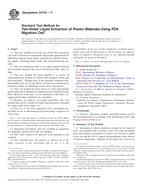 ASTM D4754-11
ASTM D4754-11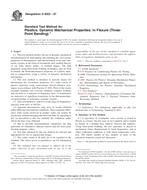 ASTM D5023-07
ASTM D5023-07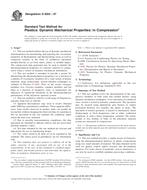 ASTM D5024-07
ASTM D5024-07
 Cookies
Cookies
